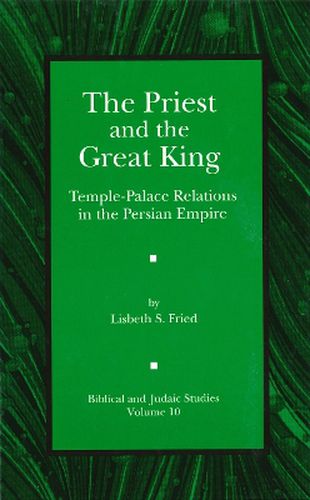Readings Newsletter
Become a Readings Member to make your shopping experience even easier.
Sign in or sign up for free!
You’re not far away from qualifying for FREE standard shipping within Australia
You’ve qualified for FREE standard shipping within Australia
The cart is loading…






Lisbeth S. Fried’s insightful study investigates the impact of Achaemenid rule on the political power of local priesthoods during the 6th-4th centuries B.C.E. Scholars typically assume that, as long as tribute was sent to Susa, the capital of the Achaemenid Empire, subject peoples remained autonomous. Fried’s work challenges this assumption. She examines the inscriptions, coins, temple archives, and literary texts from Babylon, Egypt, Asia Minor, and Judah and concludes that there was no local autonomy. The only people with power in the Empire were Persians and their appointees. This was true for Judah as well. The High Priest had no real power; there was no theocracy. The wars that periodically engulfed the Levant in the fourth century temporarily pulled the ruling governors and satraps away from Judah, and during these times, the Judean priesthood may have capitalized on the brief absence of Persian officials to mint coins, but they achieved their longed-for independence only much later, under the Maccabees.
Liz added this explanatory note in an e-mail to the Biblical Studies e-mail list on December 2, 2005:
There’s a confusion in reader’s minds about my methodology, which I’d like to set straight if I may.
The book is a rewrite of my dissertation. My dissertation was entitled The Rise to Power of the Judean Priesthood: The Impact of the Achaemenid Empire. I assumed at the outset that because the Achaemenid Empire was non-directive, and cared only that tribute would be sent regularly, the priesthood was able to fill the resulting power vacuum and achieve secular power. My goal was to chronicle the process. In addition I thought to look at Eisenstadt’s model which predicted the opposite result-that local elites, like priests, could not rise to power in an imperial system. Since there was no real data from Judah, I looked at temple-palace relations in Babylon, Egypt, and Asia Minor as well as Judah.
It was only during my research that I came to the conclusion that local priesthoods did not achieve secular power anywhere in the Achaemenid Empire and certainly not in Judah. In fact their power diminished during those 200 years. I also concluded, not that Eisenstadt was correct, but only that my data were insufficient to reject his model. However, my data were sufficient to reject the model of an Achaemenid Empire that was non-directive as well as the model of Persian authorization of local norms (Frei and Koch).
$9.00 standard shipping within Australia
FREE standard shipping within Australia for orders over $100.00
Express & International shipping calculated at checkout
Lisbeth S. Fried’s insightful study investigates the impact of Achaemenid rule on the political power of local priesthoods during the 6th-4th centuries B.C.E. Scholars typically assume that, as long as tribute was sent to Susa, the capital of the Achaemenid Empire, subject peoples remained autonomous. Fried’s work challenges this assumption. She examines the inscriptions, coins, temple archives, and literary texts from Babylon, Egypt, Asia Minor, and Judah and concludes that there was no local autonomy. The only people with power in the Empire were Persians and their appointees. This was true for Judah as well. The High Priest had no real power; there was no theocracy. The wars that periodically engulfed the Levant in the fourth century temporarily pulled the ruling governors and satraps away from Judah, and during these times, the Judean priesthood may have capitalized on the brief absence of Persian officials to mint coins, but they achieved their longed-for independence only much later, under the Maccabees.
Liz added this explanatory note in an e-mail to the Biblical Studies e-mail list on December 2, 2005:
There’s a confusion in reader’s minds about my methodology, which I’d like to set straight if I may.
The book is a rewrite of my dissertation. My dissertation was entitled The Rise to Power of the Judean Priesthood: The Impact of the Achaemenid Empire. I assumed at the outset that because the Achaemenid Empire was non-directive, and cared only that tribute would be sent regularly, the priesthood was able to fill the resulting power vacuum and achieve secular power. My goal was to chronicle the process. In addition I thought to look at Eisenstadt’s model which predicted the opposite result-that local elites, like priests, could not rise to power in an imperial system. Since there was no real data from Judah, I looked at temple-palace relations in Babylon, Egypt, and Asia Minor as well as Judah.
It was only during my research that I came to the conclusion that local priesthoods did not achieve secular power anywhere in the Achaemenid Empire and certainly not in Judah. In fact their power diminished during those 200 years. I also concluded, not that Eisenstadt was correct, but only that my data were insufficient to reject his model. However, my data were sufficient to reject the model of an Achaemenid Empire that was non-directive as well as the model of Persian authorization of local norms (Frei and Koch).